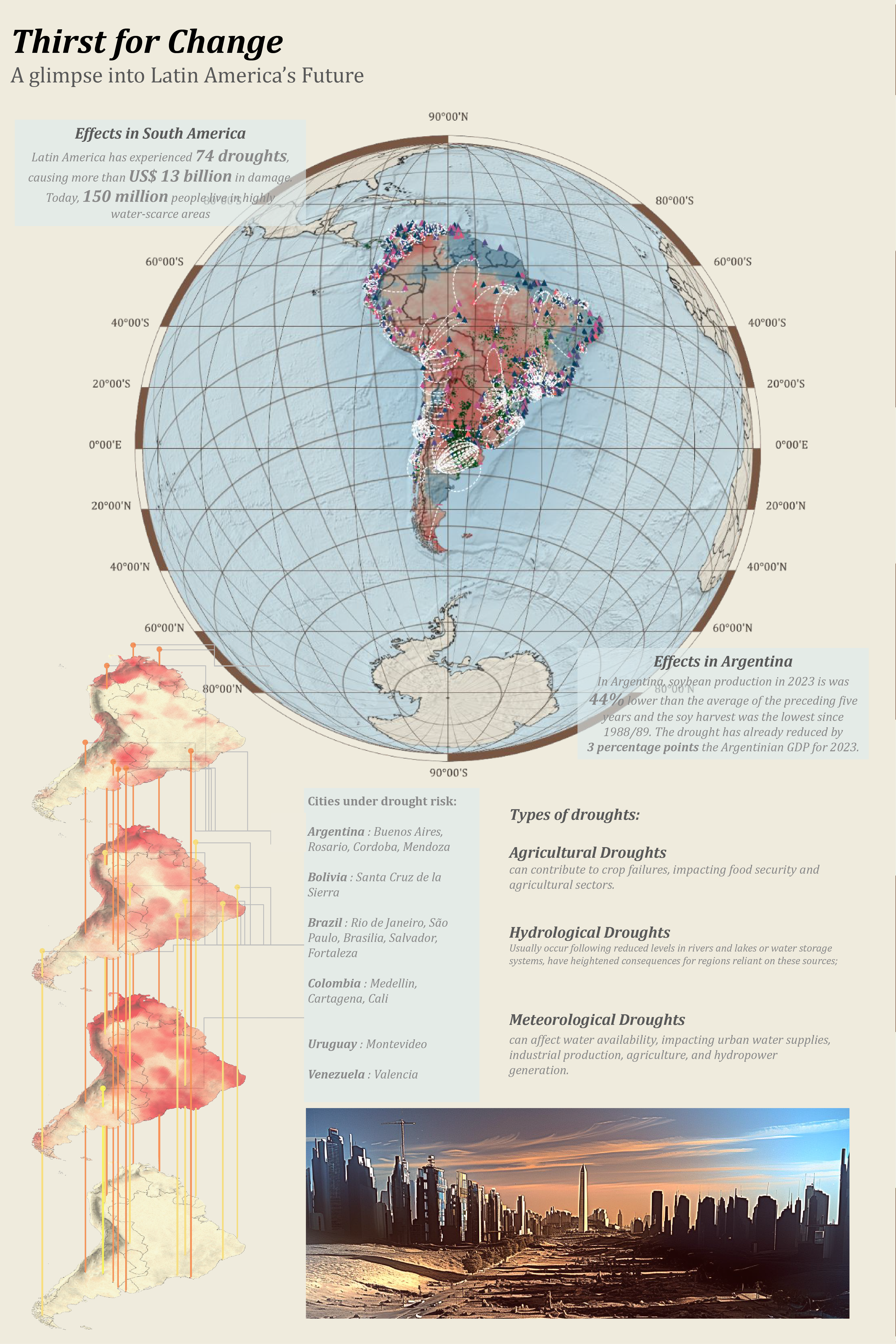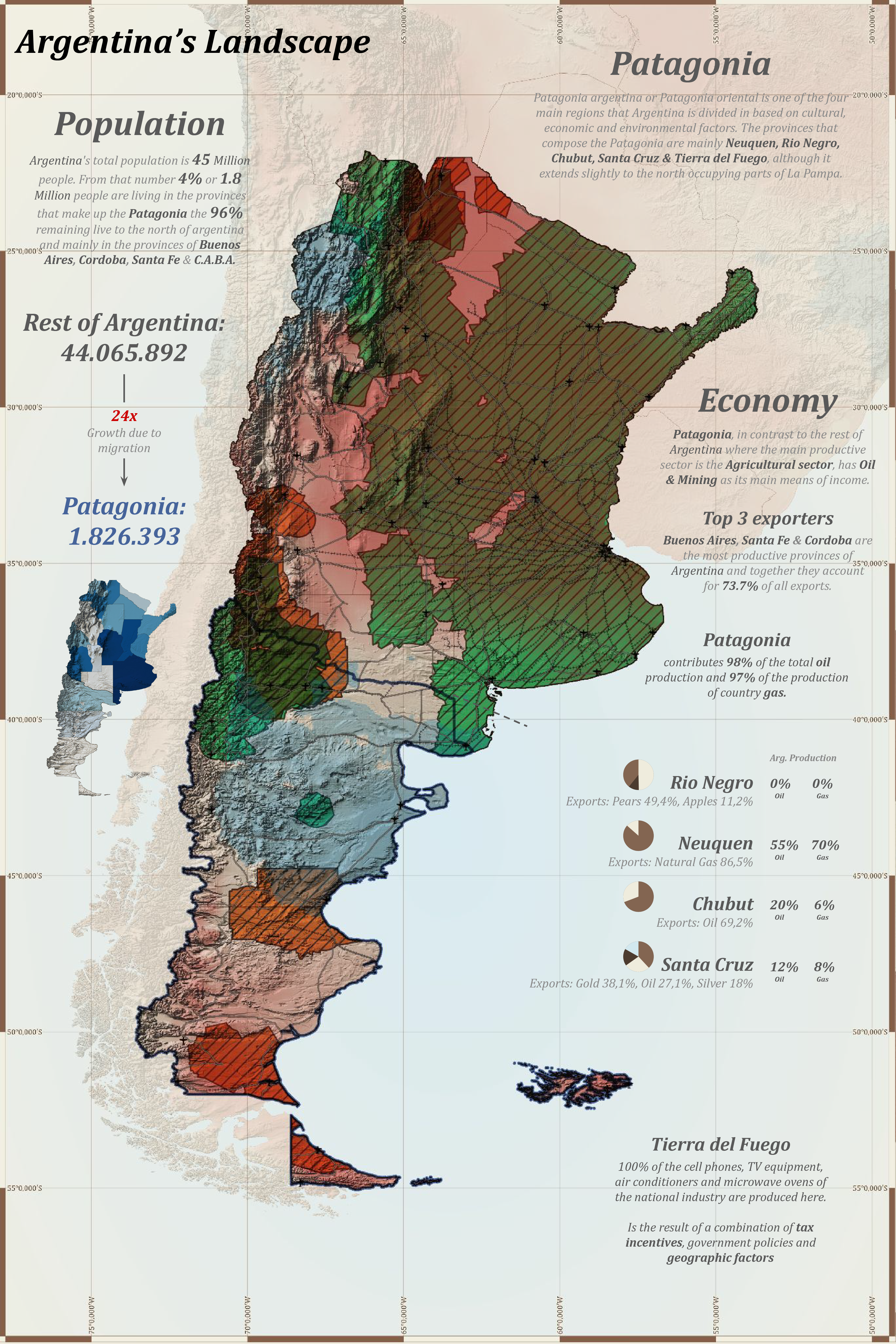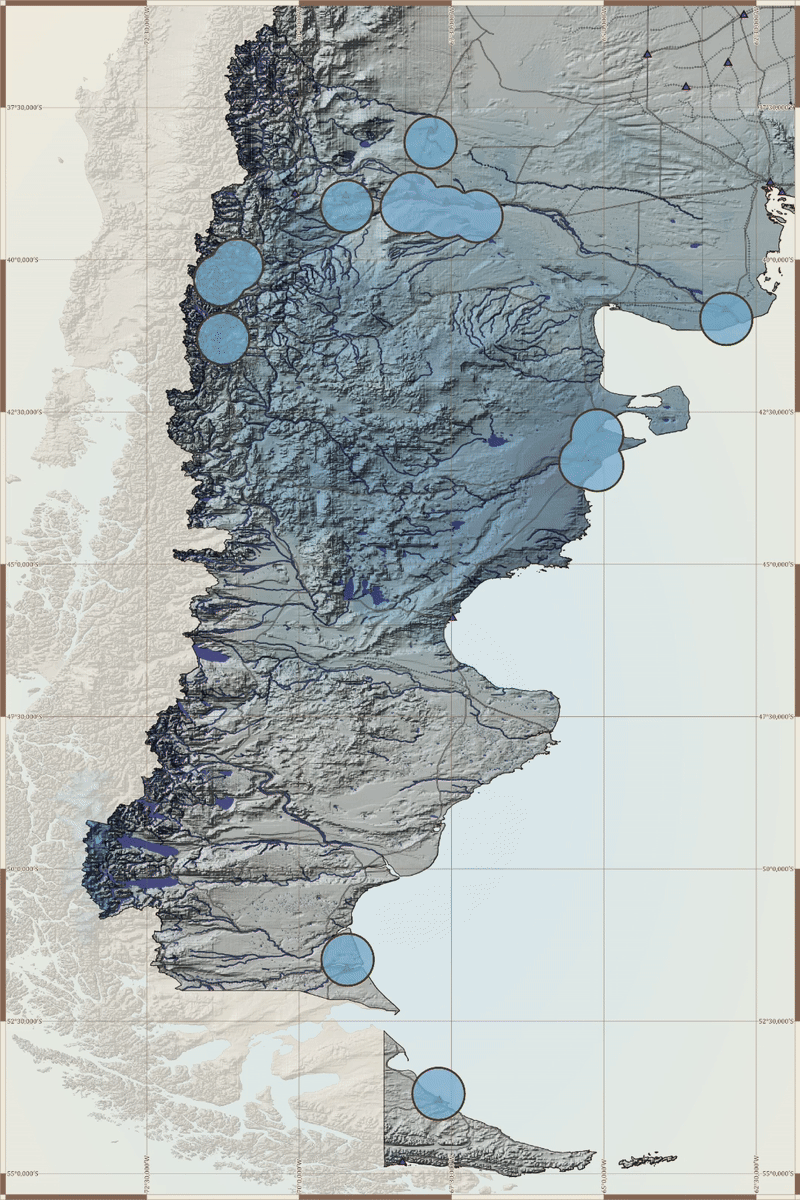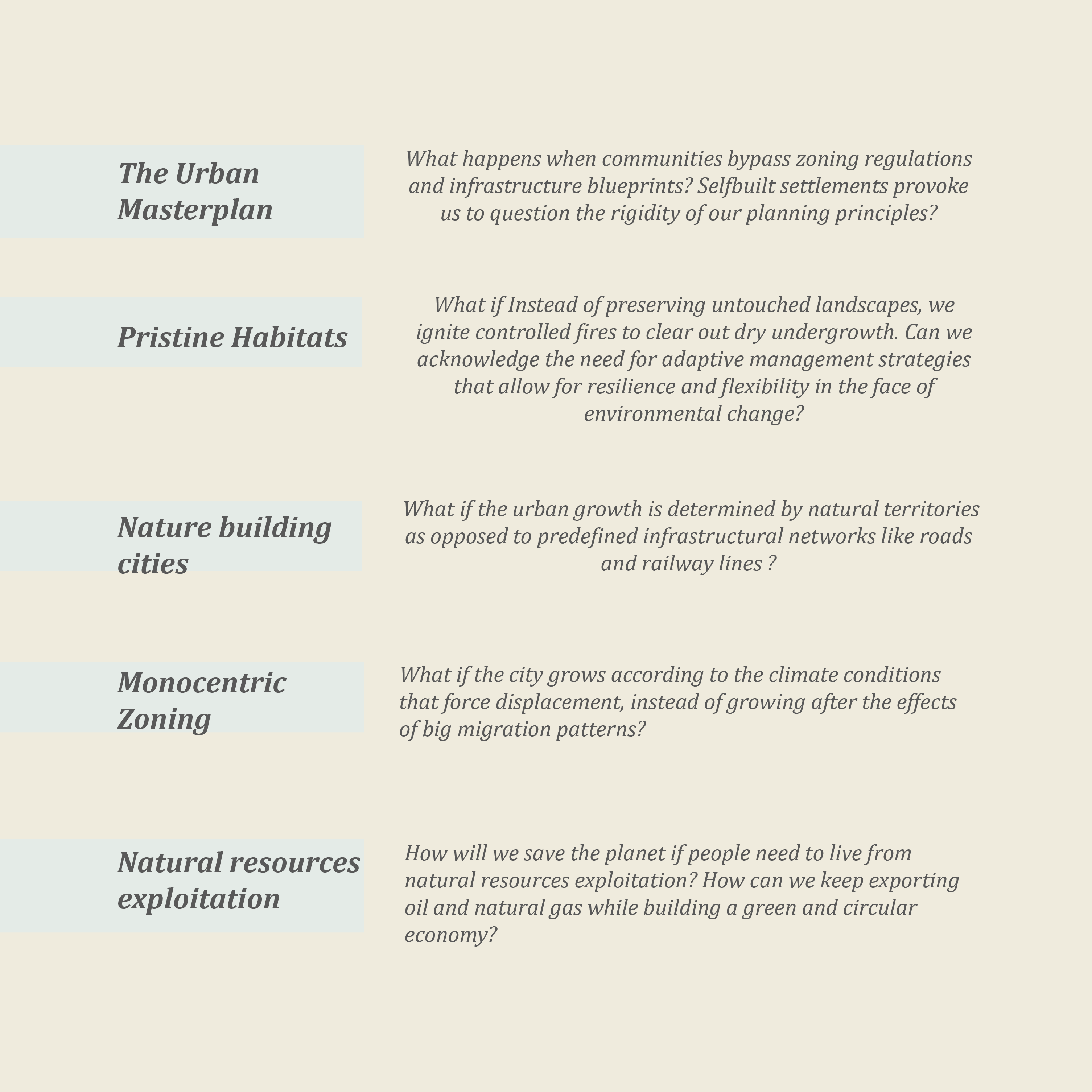Abstract
Latin America finds itself at a crossroads, facing a tightening grip from a seemingly paradoxical situation: a growing scarcity of water amidst regions prone to both droughts and floods. This foundational story explores the current and future drought conditions gripping the continent, highlighting the environmental, social, and economic challenges at play.
Introduction
Understanding the Future Scenarios of Latin American Cities

(a) The Globe: The image of the globe shows the South American continent as a whole. The map has been marked with drought susceptible areas, and the movement lines suggest migration patterns of people in such a situation.
(b) The three overlayed maps of South America mark these susceptible zones with a list of the major cities the drought would impact.
(c) The image at the bottom is a reimagination of Buenos Aires, after having been struck by a drought, and being left abandoned as people move to a location with more water resources.
Recent years have seen several major Latin American cities buckling under the pressure of severe droughts. Argentina, for instance, is experiencing its worst drought in six decades, with Buenos Aires facing the brunt of water shortages. Similar stories emerge from north eastern Brazil, where cities like São Paulo grapple with the same crisis. Cities which are all part of the South American dry corridor; Colombia’s La Guajira peninsula and Bolivia’s Andean region are not spared either. The intrigue lies in the vulnerability of these drought-stricken areas to floods as well. This flip side of the coin underscores the precarious balance of Latin America’s water resources. The region experiences natural cycles like La Niña, a climate pattern that brings cooler Pacific Ocean temperatures, influencing rainfall patterns and contributing to droughts. However, the spectre of climate change looms large, with rising global temperatures further exacerbating water scarcity. In addition, human activities like wildfires, deforestation, and soil degradation also play a significant role. These factors contribute to soil fragmentation, reducing its water retention capacity and worsening drought impacts.
Building on this situation, the project explores a distant, but rather visible future. One where a major drought has been going on in the South American continent for a few decades now. Water resources are depleting and the situation has become so desperate that, many people have started to abandon their homes and moved to settle in areas which still have resources available.
For countries like Argentina, water is a critical resource, the lifeblood of their agricultural sector. Reliable water supplies fuel the production of major export crops like soybeans, wheat, and corn, generating significant national income. Additionally, Argentina harnesses rivers for hydropower generation, a source of clean energy. However, a concerning shift is taking place. Water, a resource meant to be protected, is increasingly treated as a commodity for commercial gain. This echoes a broader societal concern of wealth concentrating in the hands of a few, often at the expense of the low income and working class. In fact statistics show that issues of drought affect 100% of low informal settlements compared to other climatic disasters.
The burden of drought is not evenly distributed. Some regions in Argentina and South America are naturally drier and more vulnerable, while others have more abundant water resources. This uneven distribution exacerbates existing social and economic inequalities. Furthermore, many indigenous communities rely heavily on water-dependent traditional practices. Droughts threaten their cultural heritage and way of life. Compounding the challenges is the lack of robust water management infrastructure in some South American countries. Deficiencies in water storage facilities, efficient irrigation systems, and early warning systems leave them less equipped to handle droughts effectively.
The consequences of these interconnected issues are stark. Latin America has already experienced significant economic losses due to droughts. In Argentina, soybean production plummeted in 2023, impacting GDP growth. With over 150 million people living in highly water-scarce areas, the competition for resources and livelihoods intensifies.
Envisioning Tomorrow: Policy Innovations for Climatic Challenges

Argentina is a big country divided in provinces. The provinces that concentrate the most part of the population are located in the north east close to the capital, Buenos Aires. The 96% of the population live in C.A.B.A, Buenos Aires, Santa Fe and Córdoba.
In the south of the country we found a region called Patagonia formed by the provinces of Neuquén, Rio Negro, Chubut, Santa Cruz and Tierra del Fuego. The area provides access abundant access to fresh water sources such as Santa Cruz and the Chubut river. Additionally, the North and the South Patagonian ice fields also contribute to freshwater supply. Collectively that makes the Patagonian region a crucial source of fresh water. However, with only 4% of the population living in Patagonia, an extreme case scenario could result a massive increase in population in all of these provinces. This in turn would increase Patagonia’s population by 24 times. To imagine an extreme situation like this one it’s important to understand how the Argentinian economy works and what would be the possibilities for this millions of migrants to establish in the south of the country.
The most important provinces in terms of economy and population are the ones in the north east mentioned above. Buenos Aires, Santa Fe and Córdoba main economic driver is agriculture being soy the major export of these provinces. Droughts have had a tremendous effect on this sector and soy agriculture is shrinking year by year.
In Patagonia, the main economic driver is the exploitation of natural resources. There is an exception with Rio Negro which has a lot of fruits agriculture like pears and apples that exports to the rest of the country and even to other countries. On the west of Rio Negro we find Neuquén which is the province that fulfills almost all the gas requirements for Argentina and Chile. Neuquén also produces oil which is mainly for national consumption given that is located almost in the middle of the country and hence the distribution is much easier than the southern provinces. Chubut is another province from Patagonia which produces oil mainly for export. On the south of Chubut we find Santa Cruz that also produces oil for export alongside precious metals like gold and silver that are exported almost entirely to Switzerland. Finally on the southern region, surrounded by sea and Chile we found Tierra del Fuego. This province is very important to understand the importance of policies in the migration movements. This is the place where all the TV’s, air conditioning, ovens and microwaves and more are produced. It is a ‘tax haven’ for these companies, and to produce these products. Maybe more policies like that could help accommodate millions of people in the south of Argentina.
Envisioning Tomorrow : Policy Innovations for Climatic Challenges

The graphic is a schematic simulation designed to first highlight potential accommodation areas for migrants coming not only from other parts of the country but possibly also from other parts of South America. Secondly, it shows that in situations of mass migration, the economically weaker sections of the population, who are dependent on self-built housing, tend to settle on the peripheries of the city, resulting in radial growth. However, since the best source of fresh water for these cities is the nearby rivers, a radial sprawl could lead to urban inequality or political injustice, where the economically weaker sections are often the ones residing in the most vulnerable locations compared to the rest of the population. This could itself become a problem.
Designing Resilience: Urban Solutions for a Sustainable Future
So, in order to tackle the coming situation, and also other problems highlighted above that would arise as a response to the situation, following questions were drafted to be engaged with critically and possibly avoid the worst case scenario.

- The Urban Masterplan : In a situation like this, we find ourselves questioning whether traditional masterplan methodologies and governance principles would even work? To navigate this future, these strategies would need to be rethought, and the inclusion of self-built construction in masterplan development would need to be encouraged.
- Pristine Habitats : In the face of climate change, perhaps some drastic steps are required. Many indigenous communities practice controlled burns to clear out dry undergrowth and protect areas that are still resilient. In situations like this, are techniques like these required to be implemented on a scale that could protect the entire Patagonian region?
- Nature Building Cities : A common practice in the face of urbanization is the development of infrastructure and services within existing metropolitan areas. However, as described above, none of the major cities in South America would be immune to drought. Perhaps a sparsely populated region like Patagonia, which might be the only area to survive, would then need to accommodate large numbers of incoming migrants. Does the solution lie in planning urban development not towards metropolitan cities, but towards strategic locations that could remain resilient in the face of such challenges? Could this approach prepare these cities for such situations?
- Monocentric Zoning : In traditional urbanization, cities typically have a single central point of jurisdiction. We also simulated above how cities would grow in the event of mass migration. However, urban inequality is bound to arise due to unequal access to water. This leads us to question whether cities need to develop in this traditional manner. Could cities instead develop parallel to rivers, allowing for equal access and the establishment of multiple centers to facilitate easier governance?
- Natural Resource Exploitation : As noted, the Patagonian region primarily focuses on exporting oil and gas, which can be seen as exploitation of natural resources. This raises the question: How can Argentina continue to export these resources to provide employment and generate revenue while simultaneously building a green and circular economy?

